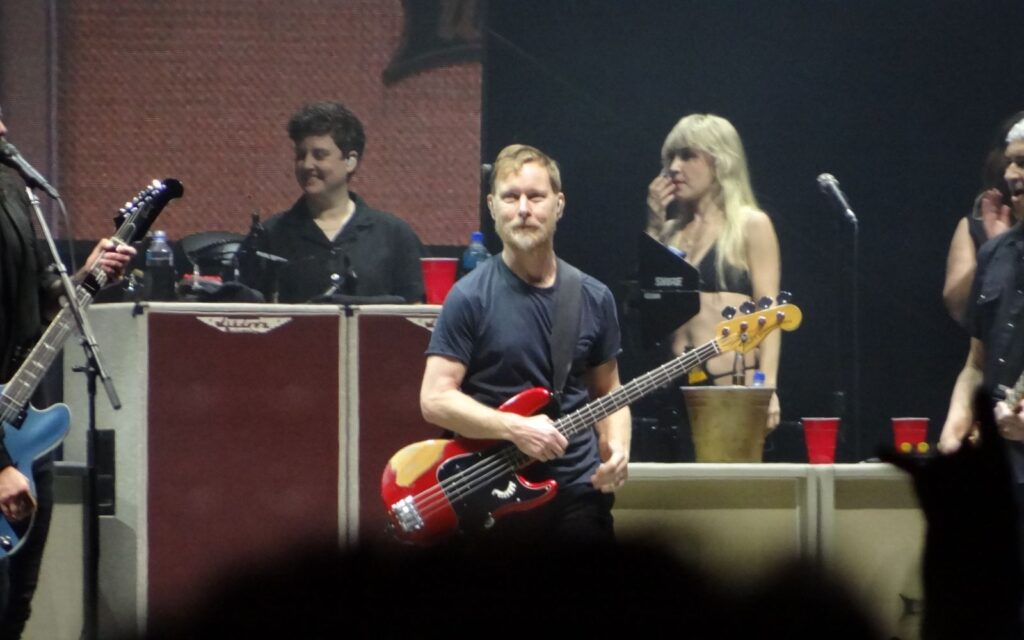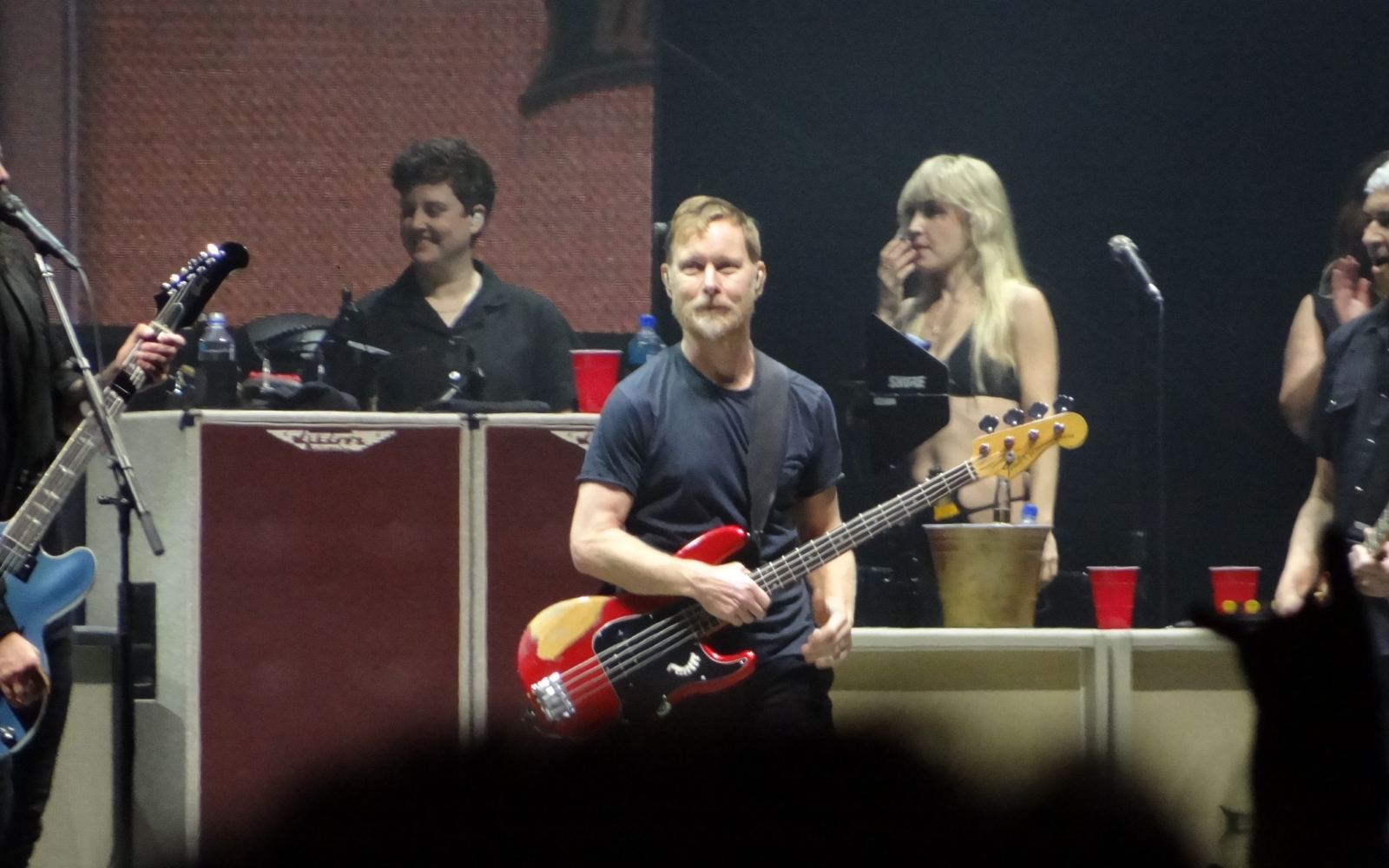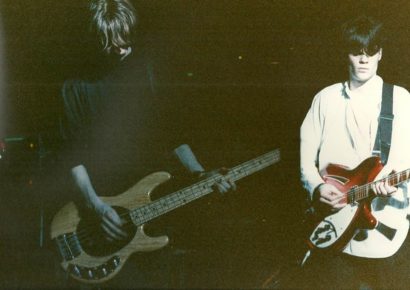Nate Mendel has been holding down the low end on stage and in the studio for decades.
Nate Mendel is as successful a musician as you can get, having been the longest serving member of the Foo Fighters besides Dave Grohl and a member of cult-status band Sunny Day Real Estate. Mendel has appeared on all of the band’s studio albums as a full band since The Colour and the Shape.
1971 FENDER PRECISION BASS
For almost all of his professional career, Mendel has played a vintage 1971 Fender P Bass, which he bought in 1987 from the lead singer of his band at the time, Christ on a Crutch. According to Mendel, the bass features a neck profile somewhere in between that of a Precision and a Jazz bass: “I really liked it. It was super easy to play and it was just a great sounding bass, and I played it on ten years-worth of records.” Since first gaining the bass 30 years ago, Mendel has played it on almost every Foo Fighters record, as well as his work with bands such as Sunny Day Real Estate and The Fire Theft.
FENDER NATE MENDEL SIGNATURE PRECISION BASS
Due to his longstanding affinity with his original 1971 bass, Mendel and Fender collaborated in 2012 to replicate the instrument in the form of the Fender Nate Mendel Signature Precision Bass. Featuring a powerful Seymour Duncan Quarter Pound pickup and a Badass II bridge, the Nate Mendel P-Bass is the ultimate rock n’ roll workhorse, perfectly complementing Mendel’s punchy downstroke playing style. In the above video, Mendel discusses the signature instrument, labeling the final result as “iconic”.
LAKLAND BOB GLAUB SIGNATURE BASS
While recording the seventh Foo Fighters LP Wasting Light, Mendel made the switch to a Lakland Bob Glaub signature bass, telling Bass Player Magazine in 2011 that the sonic characteristics of the bass better suited the analogue vibe of the record. “I played all of Wasting Light on a Lakland. We tried a few different basses, but we found the sound that worked best. We’d change the EQ to get the bass to fit in the mix.” In addition, Mendel ocassionally plays a Lakland for songs tuned to Drop D on tour, as well as appearing with one in the video for ‘The Pretender’.
GIBSON RIPPER
Mendel can be seen playing a vintage Gibson Ripper bass in the music video for Foo Fighters’ track ‘Best Of You’.
OVATION B778

For promotional shows around the release of In Your Honor, Mendel adopted an electro-acoustic Ovation B778 bass to play the acoustic numbers present on the second disc of the album.
ASHDOWN ENGINEERING
Throughout his career, Mendel has been a constant devotee to Ashdown amplifiers, praising the manufacturer for their durable amplifiers and their solid bottom end tone to match the amplitude of searing guitars favoured by Foo Fighters.

Over the years, Mendel has endorsed various amplifiers from Ashdown, including the Little Bastard head and the Ashdown BTA 400W valve head.
For touring in support of Foo Fighters’ record Concrete and Gold, Mendel has been playing an Ashdown CTM 300 head onstage, plugged into an Ashdown CL-810 8×10 fridge cabinet.
FULLTONE BASSDRIVE
On Wasting Light, Mendel played through a Fulltone Bassdrive on the supercharged track ‘White Limo’, telling Bass Player Magazine that he felt effects pedals on bass weren’t necessary while playing in such a guitar-oriented group. “Now that we have three guitar players, there’s a lot of distortion going on, so I try to keep it clean and stay in line with the kick drum. That way, I know that even if we’re playing a big echoey venue, at least the bass will come across with some bite and precision.”
ASHDOWN NATE MENDEL SIGNATURE NM2 DOUBLE DISTORTION PEDAL
Recently, Mendel collaborated with Ashdown to create the NM2 Double Distortion Pedal, a powerful distortion pedal capabale of driving a stereo bass rig to create a huge wall of low frequencies. In the above video, Mendel gushes over the power of his signature pedal, saying, “For years I was really frustrated because my band is really loud; drummers loud, guitar players are loud, and in order try and reach that volume with that much low end, in trying to do that every amp I used would just fall apart, and the Ashdown didn’t.”

